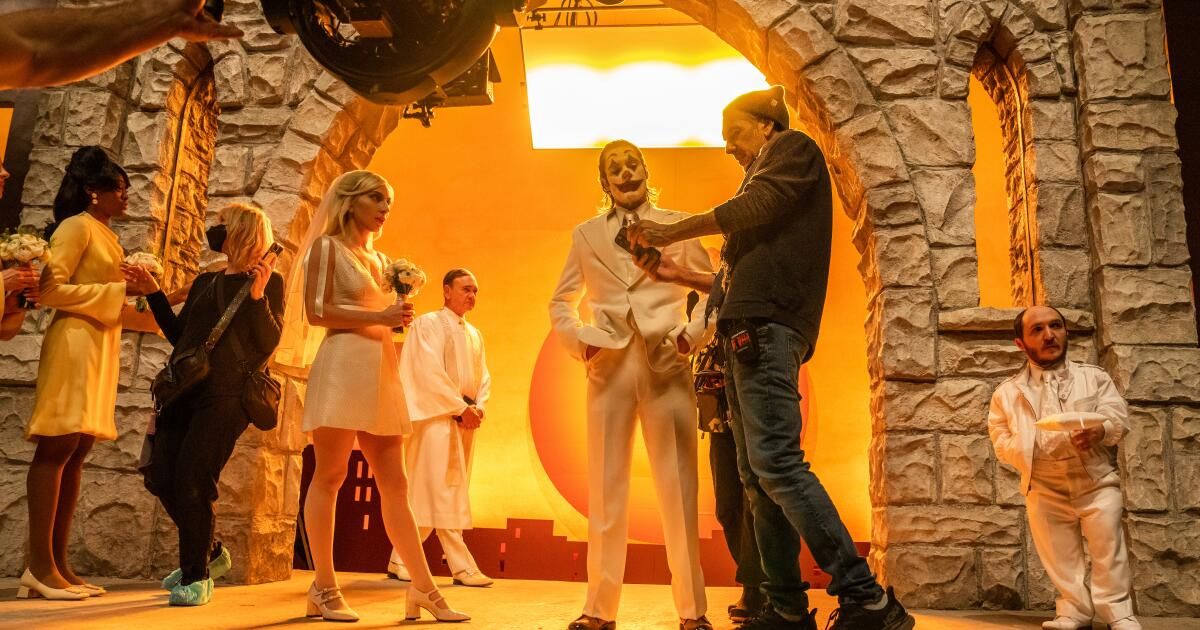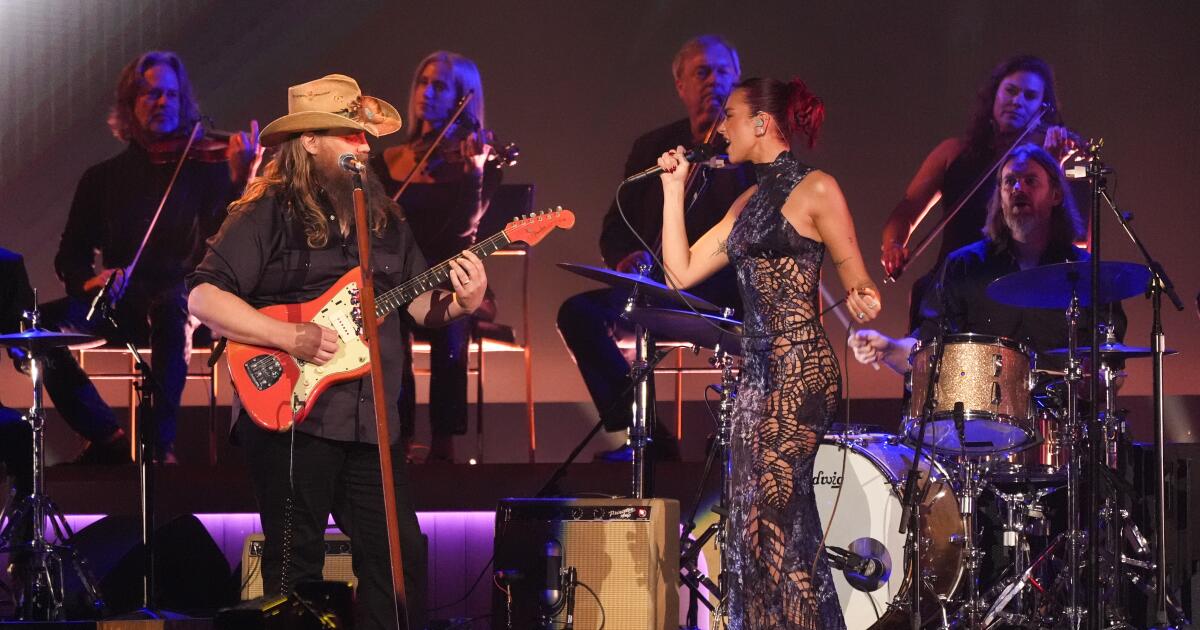The first thing you should know about “Joker: Folie à Deux” is that it is No a musical
Sure, the opening sequence features posters for “Modern Times,” “Pal Joey,” and “Shall We Dance.” One scene shows Arkham Asylum inmates watching the 1953 film “The Band Wagon,” with Arthur Fleck (Joaquin Phoenix) talking to Fred Astaire and getting angry when Lee Quinzel (Lady Gaga) refuses to watch. In another, the two prisoners are seen singing the spectacular song from “Sweet Charity”, “If My Friends Could See Me Now”. At one point, the Joker even starts tap dancing.
But the melodious moments and some movements do not constitute a musical. And that disconnect between what the film appears to be and what it actually manages to achieve is the basis of its failure. Compared to Warner Bros.' A 2019 original that won two Academy Awards and grossed more than $1 billion worldwide, director Todd Phillips' sequel doesn't have the courage of its own convictions, nor those of any great musical. with a The opening weekend domestic box office grossed $40 million. and a Cinemascore of D, it seems the audience smelled it for themselves.
Make no mistake, though: It's not that the musical genre, often mistakenly reduced to smiley song-and-dance routines and happily-ever-after endings, can't be as raw and dark as “Joker” would require (see “Sweeney Todd: The Demon Barber of Fleet Street”, “Assassins”, “Cabaret”). Or that it cannot address sensitive topics such as mental illness (“The Light in the Square”, “Anyone Can Whistle”), social rejection (“Be More Chill”, “Oklahoma!”), drug addiction (“Next to Normal ”, “Jagged Little Pill”), sexual assault (“Spring Awakening”, “The Color Purple”) or suicidal ideation (“Fun Home”, “Dear Evan Hansen”).
Joaquin Phoenix in “Joker: Folie à Deux.”
(Warner brothers)
Musicals are equally flexible in their form.despite what the haters may have you think. Characters in a musical may sing their feelings because direct dialogue fails to achieve adequate self-expression, or sing as a completely normal mode of communication in their world. Even committed realists can work within the musical genre, with an entirely diegetic score and a narrative framed around a concert or performance.
However, in any of the above configurations, one thing remains true: a musical advances its story by taking seriously the disciplines (composition, vocal performance, orchestrations, dance, etc.) on which it is built, showing, celebrating and even innovating these. craft. “Folie à Deux,” though at times it looks like a musical and at times even sounds like a musical, seems to take nothing seriously, except perhaps itself.
In particular, “Folie à Deux” grossly underestimates the narrative power of the jukebox musical, which organizes existing music into a new narrative. While taking advantage of the viewer's familiarity with the tunes, jukebox musicals also have a unique opportunity to turn a hit song on its head, either to reveal something new to the story or simply to be clever, as when “& Juliet” rephrases the Britney Spears song. “I'm Not a Girl, Not Yet a Woman” to detail the identity journey of a non-binary character, or “Tina: The Tina Turner Musical” uses the seductive 1984 hit “Private Dancer” to mark the desperate appeal of the singer to perform in Las Vegas Bars.
In contrast, most of the songs on “Folie à Deux” serve no apparent purpose and offer little new information or insight into their characters. With the exception of Lee referencing “(They Long to Be) Close to You” to blatantly illustrate his obsession with Arthur's alter ego, it's as if the film is mentioning themes rather than telling stories through them; It would be like reading a syllabus and saying that you have completed the class.
The film also features unnerving vocal performances from Phoenix and Gaga. To express Arthur's romantic attraction to Lee, Phoenix performs “For Once in My Life” and “Bewitched (Bothered and Bewildered),” songs regularly performed with the enthusiasm of a lovestruck Tom Cruise jumping on Oprah Winfrey's couch. But here, Phoenix, who previously showed off his powerful pipes in his Oscar-winning performance as Johnny Cash in “Walk the Line,” does so with a frustrating weakness, which is especially depressing against the lush orchestra that accompanies him.
Maybe it's because the emaciated Arthur isn't in his empowered Joker state and can't get the strongest vocal line, or because the actors were tasked with singing live on set. Still, many standout stage numbers – “Flores” from “Hadestown,” “I Dreamed a Dream” from “Les Miserables” – begin relatively delicately, as their damaged characters are at their lowest moments and presented with a fragility. that is both emotionally palpable and pleasing to the ear.
Phoenix only performs one solo as Joker: appropriately, “The Joker,” from the 1964 musical “The Roar of the Greasepaint – The Smell of the Crowd.” And it's a huge disappointment to arrive 90 minutes into the courtroom drama and still transfixed by vocal restraint. To what end? As decades of Disney animated films have taught us, The antagonists usually get the best musical numbers.with the freedom to be as self-centered and bombastic as, well, the Joker from the 2019 movie.
But the villain who Joker from the Bronx danced deliciously down the stairs Smoking, high kicks, and remorseless pelvic thrusts (a now-iconic minute-long sequence that arguably showed what a “Joker” musical could look like) are nowhere to be found in this sequel. All its musical numbers are dream sequences. Arthur/Joker could be as talented a performer as he imagines himself to be, if not for his sake, then at least for the viewer's!
Likewise, Lady Gaga's vocal prowess is drastically underutilized, an unwise decision given that she is one of the world's biggest pop stars and won two Grammy Awards for her songs on the Great American Songbook with Tony Bennett. (Strategically, Gaga just released “Harlequin,” a relatively theatrical companion album in which she covers some of the film's songs herself, regardless of which character performs them on screen. I'm still debating whether releasing her jazzy rendition of “Get Happy”, his guitar version of “The Joker” and his originals “Folie à Deux” and “Happy Mistake” are either comfort after watching the movie or salt in the wound).

Joaquin Phoenix and director Todd Phillips on the set of “Joker: Folie à Deux.”
(Warner brothers)
The most obvious evidence that “Folie à Deux” has gotten the musical wrong is the strange decision to shorten most of these sequences, decades-old compositions before their emotional and musical resolutions. The reason for doing it repeatedly is never made clear and feels as jarring as suddenly cutting a fight scene or soliloquy. If these numbers had been filmed in their entirety, cutting their final bars might have reduced the overall running time, but at the cost of further irritating the audience.
What exacerbates the musical miscalculation of “Folie à Deux” is the creative team's apparent embarrassment at their association with the genre. “I think the way we approached the music in this movie was very special and very nuanced,” Gaga said. he said at a Venice Film Festival press conference. “I wouldn't necessarily say this is really a musical; In many ways, it is very different. The way music is used is to give the characters a way to express what they need to say because the scene and just the dialogue are not enough.”
“I just don't want people to think it's like 'In the Heights,' where the grocery lady starts singing and they take it out into the street, and the police are dancing,” Phillips said in a Variety cover storyreferring Warner Bros.' jubilant release of 2021. “No disrespect, because I loved 'In the Heights.' “
And as for all those off-key notes, “Neither Arthur nor Lee are professional singers, and they shouldn't sound like they are,” Gaga said. said fashionably. Phoenix added: “Anime [Gaga] sing badly.”
If Phillips had actually made a full-throated “Joker” musical and celebrated it in the press, it would have been a creative risk worthy of admiration, even if it had fallen short. Instead, when Arthur begs Lee in one scene to “stop singing” and “just talk to me,” I couldn't help but agree.
Thank goodness it's not a musical.












